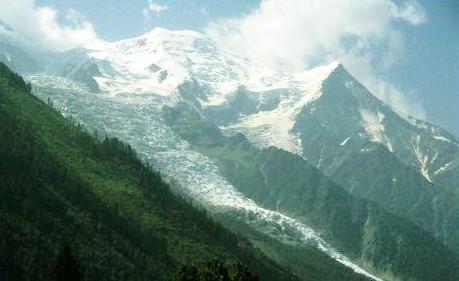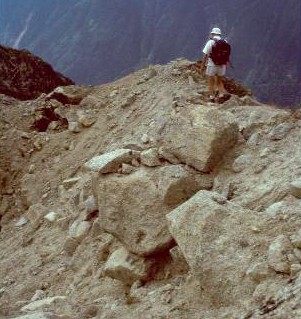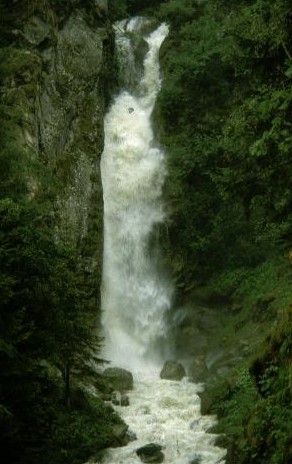Origins of Fold Mountains
 Fold
mountains are created by uplift and folding of tectonic plates as they move
towards each other and collide. This is known as a compressional plate margin.
An example is the Andes Mountain range in South America()
Fold
mountains are created by uplift and folding of tectonic plates as they move
towards each other and collide. This is known as a compressional plate margin.
An example is the Andes Mountain range in South America()
The plates may be either 'continental and continental' or 'continental and oceanic'. The plates move towards each other, but there isn't a free space for them to move into because they are already touching each other. With two massive plates of rock pushing against each other and continually moving, all that rock has to go somewhere!
At a destructive plate margin where oceanic and continental plates collide, the oceanic plate is subducted, pulled under the continental plate - whilst the continental plate is crumpled upwards to form a mountain range. The Andes are an example of fold mountains formed at a destructive plate margin.
When two continental plates move towards each other, both plates are forced upwards in a series of folds. This caused big problems for early geologists who struggled to explain why they were finding fossils of sea creatures high up in mountains such as the Himalayas! We now know that the fossils got there due to uplift of sedimentary rocks found along the edges of the plates. ()
You can simulate this process using two flat strips of modeling clay or old carpet. Put them side by side and push them together. One or both will crumple up and form a mini mountain range on your table top.
Human Activity in Fold Mountains
 The
European Alps are a popular tourist location, as well as home to over eleven
million people. Countries such as France,Italy,Switzerland,Austria and Germany
have developed tourism in their mountains and have thriving tourism sectors.
Not all fold mountain areas as as well developed as the Alps of course. The
Himalayas are popular with tourists, but much harder for Europeans, Africans
and Americans to get to. Whilst the European Alps are the most populated mountains
in the world, the Himalayas have a low population density and are so high that
people cannot survive for long in the highest parts!
The
European Alps are a popular tourist location, as well as home to over eleven
million people. Countries such as France,Italy,Switzerland,Austria and Germany
have developed tourism in their mountains and have thriving tourism sectors.
Not all fold mountain areas as as well developed as the Alps of course. The
Himalayas are popular with tourists, but much harder for Europeans, Africans
and Americans to get to. Whilst the European Alps are the most populated mountains
in the world, the Himalayas have a low population density and are so high that
people cannot survive for long in the highest parts!
In the Alps the economy is based on forestry (coniferous trees on steep slopes), keeping dairy cattle and sheep (valley floors, and high pasture in summer), herding goats in the highest areas, and meeting the needs of tourists throughout the summer and winter.
The Alps have hot, dry summers and cold, snowy winters, so the tourism industry has two profitable seasons; Summer and Winter.
During the summer (June to September) the area fills with tourists from across Europe, staying in hotels, camping sites and rented homes. Typical summer activities include walking, climbing, enjoying the clean air and beautiful views, hang gliding and other adventure activities.
Winter brings skiing, winter climbing, snow boarding and people wanting a 'traditional' Christmas with snow, sleighs and fir trees. Many winter resorts have been built specifically for tourism, such as Les Deux Alps and Val d'Isere, whilst others have adapted over time, such as Chamonix, Val Ferret and Grindelwald. Most winter resorts have a well developed summer tourist industry too.
Power Generation in Fold Mountains
 The steep slopes and warm summers
when glacial melt water is plentiful make the Alps ideal for the production
of electricity through Hydroelectric power plants (HEP). The guaranteed electricity
supply has attracted industries that need cheap and plentiful electricity,
such as aluminium smelting, specialist metal products and electro-chemical
plants. Amazingly, the first HEP system was installed in Switzerland in 1878,
when a turbine in a stream produced power to light the dining room of the Palace
Hotel in St.Moritz .
The steep slopes and warm summers
when glacial melt water is plentiful make the Alps ideal for the production
of electricity through Hydroelectric power plants (HEP). The guaranteed electricity
supply has attracted industries that need cheap and plentiful electricity,
such as aluminium smelting, specialist metal products and electro-chemical
plants. Amazingly, the first HEP system was installed in Switzerland in 1878,
when a turbine in a stream produced power to light the dining room of the Palace
Hotel in St.Moritz .
HEP took of after the Second World War when it became possible to transmit the power over long distances and produce more and more power from better power plants. Today, almost two thirds of Switzerland's electricity comes from HEP. Hydro-electric power has important ecological advantages because it doesn't produce air pollution, greenhouse gases or waste products. It is renewable too, so once the plant is built you don't have 'raw materials' costs as you do with coal or oil powered generation.
On the other hand, to ensure a constant water supply for a modern
HEP plant, it is necessary to create reservoirs. Local people can sometimes
object to this, especially if their homes are in a valley due to be flooded
to create a new reservoir. Additionally, because the rivers are now controlled
and flow into reservoirs before they reach the lowland valleys, their ecosystems
have changed. Rivers that used to be fast flowing have less water in them,
and are more likely to become polluted. To protect them, governments set minimum
discharge rates through the HEP dams to ensure that the rivers keep flowing.
The people running the HEP plants don't always like this because water that
is discharged without going through the turbines doesn't produce electricity
or profits. It's a delicate balancing act between the needs of power users
and the needs of the ecosystem and other river users.
![]()
